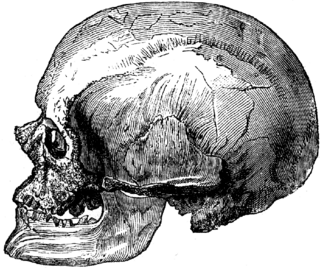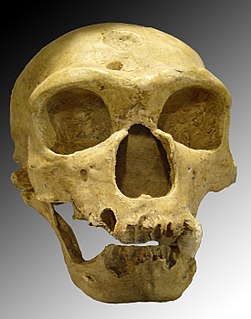
Behavioral modernity is a suite of behavioral and cognitive traits that distinguishes current Homo sapiens from other anatomically modern humans, hominins, and primates. Although often debated, most scholars agree that modern human behavior can be characterized by abstract thinking, planning depth, symbolic behavior, music and dance, exploitation of large game, and blade technology, among others. Underlying these behaviors and technological innovations are cognitive and cultural foundations that have been documented experimentally and ethnographically. Some of these human universal patterns are cumulative cultural adaptation, social norms, language, and extensive help and cooperation beyond close kin. It has been argued that the development of these modern behavioral traits, in combination with the climatic conditions of the Last Glacial Maximum, was largely responsible for the human replacement of Neanderthals and the other species of humans of the rest of the world.

The Max Planck Institute for Evolutionary Anthropology is a research institute based in Leipzig, Germany, founded in 1997. It is part of the Max Planck Society network.

Pleistocene megafauna is the set of large animals that lived on Earth during the Pleistocene epoch and became extinct during the Quaternary extinction event. Megafauna is a term used to describe animals with an adult body weight of over 44 kg.

The Upper Paleolithic is the third and last subdivision of the Paleolithic or Old Stone Age. Very broadly, it dates to between 50,000 and 10,000 years ago, according to some theories coinciding with the appearance of behavioral modernity and before the advent of agriculture.
Neanderthal extinction began around 40,000 years ago in the Paleolithic Europe, after anatomically modern humans had reached the continent. This date, which is based on research published in Nature in 2014, is much earlier than previous estimates, and it was established through improved radio carbon dating methods analyzing 40 sites from Spain to Russia. The survey did not include sites in Asia, where Neanderthals may have survived longer. Evidence for continued Neanderthal presence in the Iberian Peninsula at 37,000 years ago was published in 2017.

The prehistory of the Iberian Peninsula begins with the arrival of the first hominins 1.2 million years ago and ends with the Punic Wars, when the territory enters the domains of written history. In this long period, some of its most significant landmarks were to host the last stand of the Neanderthal people, to develop some of the most impressive Paleolithic art, alongside southern France, to be the seat of the earliest civilizations of Western Europe and finally to become a most desired colonial objective due to its strategic position and its many mineral riches.

Paleolithic Europe, the Lower or Old Stone Age in Europe encompasses the era from the arrival of the first archaic humans, about 1.4 million years ago until the beginning of the Mesolithic around 10,000 years ago. This period thus covers over 99% of the total human presence on the European continent. The early arrival and disappearance of Homo erectus and Homo heidelbergensis, the appearance, complete evolution and eventual demise of Homo neanderthalensis and the immigration and successful settlement of Homo sapiens all have taken place during the European Paleolithic.

The Sidrón Cave is a non-carboniferous limestone karst cave system located in the Piloña municipality of Asturias, northwestern Spain, where Paleolithic rock art and the fossils of more than a dozen Neanderthals were found. Declared a "Partial Natural Reserve" in 1995, the site also serves as a retreat for five species of bats and is the place of discovery of two species of Coleoptera (beetles).

The Grotte du Renne is one of the many caves at Arcy-sur-Cure in France, an archaeological site of the Middle/Upper Paleolithic period in the Yonne departement, Bourgogne-Franche-Comté. It contains Châtelperronian lithic industry and Neanderthal remains. Grotte du Renne has been argued to provide the best evidence that Neanderthals developed aspects of modern behaviour before contact with modern humans, but this has been challenged by radiological dates, which suggest mixing of later human artifacts with Neanderthal remains. However, it has also been argued that the radiometric dates have been affected by post-recovery contamination, and statistical testing suggests the association between Neanderthal remains, Châtelperronian artefacts and personal ornaments is genuine, not the result of post-depositional processes.

The Hohle Fels is a cave in the Swabian Jura of Germany that has yielded a number of important archaeological finds dating to the Upper Paleolithic. Artifacts found in the cave represent some of the earliest examples of prehistoric art and musical instruments ever discovered. The cave is just outside the town of Schelklingen in the state of Baden-Württemberg, near Ulm. In 2017 the site became part of the UNESCO World Heritage Site "Caves and Ice Age Art in the Swabian Jura".

European early modern humans (EEMH) in the context of the Upper Paleolithic in Europe refers to the early presence of anatomically modern humans in Europe. The term "early modern" is usually taken to include fossils of the Bohunician, Ahmarian, Aurignacian, Gravettian, Solutrean and Magdalenian, extending throughout the Last Glacial Maximum (LGM), covering the period of roughly 48,000 to 15,000 years ago, usually referred to as the Cro-Magnon. The earliest sites in Europe dated 48,000 years ago are Riparo Mochi (Italy), Geissenklösterle (Germany), and Isturitz (France) The upper limit of 15,000 marks the transition to the European Mesolithic, depending on the region also given in the range of 12,000 to 10,000 years ago.
Hominid dispersals in Europe refers to the colonisation of the European continent by various species of hominid, including hominins and archaic and modern humans.

La Grotte des Fées is a cave located in Châtelperron, in the French department of Allier, in the Auvergne region.

The Brillenhöhle is a cave ruin, located 16 km (9.94 mi) west of Ulm on the Swabian Alb in south-western Germany, where archaeological excavations have documented human habitation since as early as 30,000 years ago. Excavated by Gustav Riek from 1955 to 1963, the cave's Upper Paleolithic layers contain a sequence of Aurignacian, Gravettian and Magdalenian artifacts. In 1956 the first human fossils were discovered within a fireplace in the center of the cave, a discovery which made important contributions to the foundational understanding of the Magdalenian culture of central Europe.

The Goyet Caves are a series of connected caves located in a limestone cliff about 15 m above the river Samson near the village of Mozet in the Gesves municipality of the Namur province, Belgium. The site is a significant locality of regional Neanderthal and European early modern human occupation, as thousands of fossils and artifacts were discovered that are all attributed to a long and contiguous stratigraphic sequence from 120,000 years ago, the Middle Palaeolithic to less than 5.000 years ago, the late Neolithic. A robust sequence of sediments was identified during extensive excavations by geologist Edouard Dupont, who undertook the first probings as early as 1867. The site was added to the Belgian National Heritage register in 1976.
Katerina Harvati is a Greek paleoanthropologist and expert in early human evolution. She specializes in the broad application of 3-D geometric morphometric and virtual anthropology methods to paleoanthropology. Since 2009, she has been full professor and director of Paleoanthropology at the University of Tübingen, Germany.




















